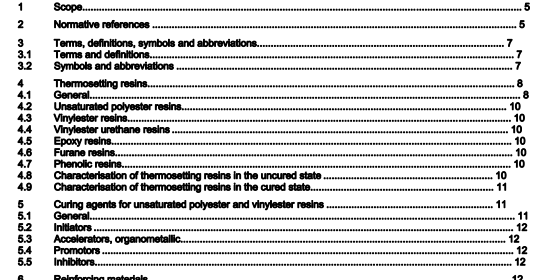BS EN 13121-1:2003 – GRP tanks and vessels for use above ground — Part 1: Raw materials — Specification conditions and acceptance conditions

4.2 Unsaturated polyester resins Unsaturated polyester resins (UP) are thermosetting resins consisting of polyester molecules, dissolved in a reac- tive monomer (e.g. styrene) capable of copolymerisation with the polyester. The polyester molecules are built from polyhydric alcohols (polyols) and polyvalent carboxylic acids (e.g. ethylene dicarboxylic acids like fumaric acid and/or maleic acid) and cyclic unsaturated hydrocarbons (e.g. dicyclopentadiene) by a polymerisation reaction. At least one of the acids is unsaturated (in UP-resins usually maleic and/or fumaric acid is used).
4.3 Vinylester resins Vinylester resins (VE) are thermosetting resins consisting of phenyl- and/or phenylene derivatives (e.g. glycidyle ther from bisphenol A or novolak) and ester terminated with acrylic- and/or methacrylic acid. The vinylester molecules are built up by reaction of an epoxide with (meth)acrylic acid. The vinylester molecules are dissolved in a reactive monomer (e.g. styrene) capable of copolymerisation with the unsaturated vinylester molecules.
4.4 Vinylester urethane resins Vinylester urethane resins (VEU) are thermosetting resins consisting of phenyl- and/or phenylene derivates (e.g. dialkoxy-bisphenol A), fumaric/maleic acid, diisocyanate derivates and terminated with alkoxy-(meth)acrylate. The vinylester urethane molecules are built up by the reaction of a diisocyanate derivate with alkoxy-(meth)acrylate and the condensation product of dialkoxy-bisphenol A with fumaric/maleic acid. The vinylester urethane molecules are dissolved in a reactive monomer (e.g. styrene) capable of copolymerisation with the unsaturated vinylester molecules.
4.5 Epoxy resins Epoxy resins (EP) are low to medium molecular weight polymers containing the oxirane (epoxide) reactive group. Crosslinking occurs at these sites through addition of amines, Lewis acids/bases and anhydrides. The epoxy resin system is characterised by the type of epoxy resin (e.g. diglycidyl ether of bisphenol A, diglycidyl ether of bisphenol F), the type of curing agent [e.g. (cyclo)aliphatic or aromatic amine, anhydride] and, if used, the type of viscosity modifier (e.g. “reactive-” or “non-reactive diluent”).
4.6 Furane resins Furane resins (FU) are prepolymers of furfuryl alcohol dissolved in monomeric furfuryl alcohol
. They polymerise via a condensation reaction on addition of an acid catalyst (typically para-toluene sulphonic acid or phosphoric acid), water being liberated.
4.7 Phenolic resins Phenolic resins (PF) are the reaction product of phenol and an aldehyde, typically formaldehyde. They polymerize by a condensation reaction on addition of an acid catalyst (typically para-toluene sulphonic acid or phosphoric acid), water being liberated (analogous to the furane resins).
4.8 Characterisation of thermosetting resins in the uncured state Thermosetting resins shall be characterised in the uncured state by the resin manufacturer by the properties given in Table 3.
BS EN 13121-1:2003 – GRP tanks and vessels for use above ground — Part 1: Raw materials — Specification conditions and acceptance conditions